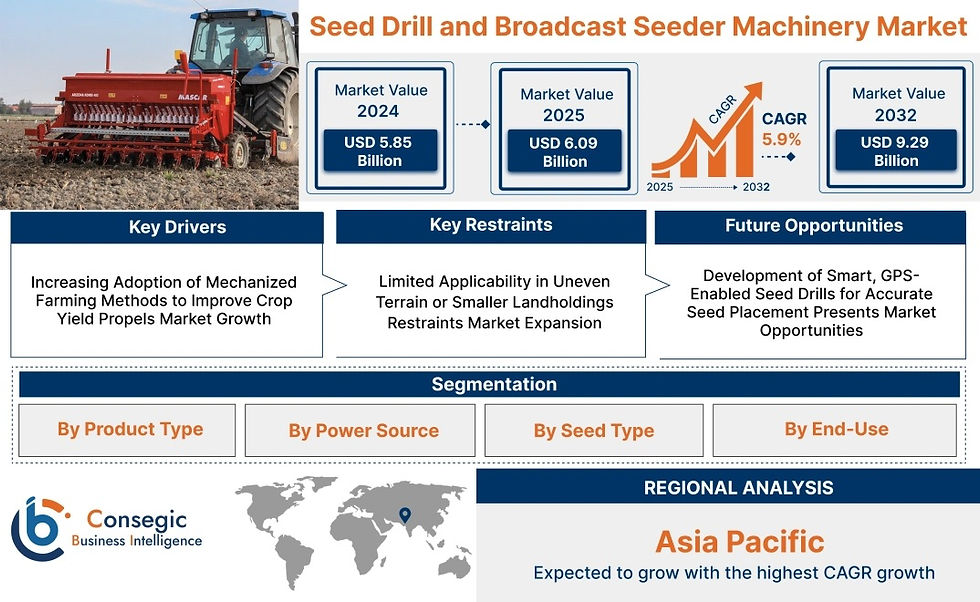Thermal Transfer Label Market Growth Drivers & Future Opportunities
- Anurag ConsengicBusinessIntelligence
- Mar 24
- 3 min read
1. Market Overview:
Thermal transfer labels are labels printed using a thermal printhead and a thermal transfer ribbon. This process creates durable, high-resolution prints that are resistant to heat, chemicals, and abrasion. These labels are widely used in industries such as manufacturing, logistics, healthcare, retail, and food and beverage for product identification, tracking, and compliance labeling. The market is influenced by factors such as the growing demand for barcode and RFID labels, the need for accurate inventory management, and the increasing adoption of automated labeling systems.
2. Market Drivers:
Increasing Demand for Durable Labeling Solutions: Industries requiring labels that can withstand harsh environments, such as extreme temperatures, chemicals, and abrasion, are driving the demand for thermal transfer labels.
Growth of the Logistics and E-commerce Industries: The rapid expansion of logistics and e-commerce has led to a surge in the need for accurate and efficient labeling for tracking and shipping purposes.
Stringent Regulatory Requirements: Industries such as healthcare and pharmaceuticals have stringent regulatory requirements for product labeling, driving the adoption of reliable and compliant labeling solutions.
Adoption of Barcode and RFID Technology: The increasing adoption of barcode and RFID technology for inventory management and tracking is driving the demand for thermal transfer labels.
Automation in Manufacturing and Warehousing: The growing trend of automation in manufacturing and warehousing is driving the need for automated labeling systems that utilize thermal transfer labels.
Increased need for product traceability.
3. Market Restraints:
Higher Cost Compared to Direct Thermal Labels: Thermal transfer labels are generally more expensive than direct thermal labels, which can be a restraint for price-sensitive industries.
Environmental Concerns Related to Ribbon Disposal: The disposal of thermal transfer ribbons can raise environmental concerns, as they may contain non-biodegradable materials.
Technological Shift to Direct Part Marking: In some industrial applications, direct part marking technologies, such as laser marking, may be preferred over thermal transfer labels.
Complexity of System Integration: Integrating thermal transfer label printers with existing enterprise systems can be complex and require specialized expertise.
Fluctuations in raw material prices.
4. Market Opportunities:
Development of Eco-Friendly Ribbons and Labels: The development of eco-friendly thermal transfer ribbons and labels can address environmental concerns and attract environmentally conscious customers.
Integration with IoT and Cloud-Based Solutions: Integrating thermal transfer label printers with IoT and cloud-based solutions can enable real-time tracking and monitoring of labeled products.
Expansion into Emerging Markets: The growing industrialization and urbanization in emerging markets present significant opportunities for the thermal transfer label market.
Customization and Personalization: Offering customized and personalized thermal transfer label solutions can cater to specific customer needs and preferences.
Development of Smart Labels: The development of smart labels that can store and transmit data can enhance product traceability and authentication.
Increase in demand for labels that can withstand extreme environments.
5. Market Key Players:
3M (United States), Thermal transfer printer labels on rolls (United States), OMNI Systems LLC (United States), Honeywell International Inc (United States), Lintec Corporation (Japan), Zebra (United States), JK Labels (India), American Tape & Label Co (United States), ADAZON (United States), Lynx (United States)
6. Market Segmentation:
By Material: Paper, Polyester, Polypropylene, Polyvinyl Chloride, Others
By End Use Industry: Food and Beverage, Pharmaceutical, Logistics & Transportation, Industrial Goods, Electronics, Others
7. Market Regional Analysis:
Asia-Pacific, Europe, North America, Latin America, Middle East & Africa
8. Market Recent Developments:
Development of advanced thermal printheads with improved print quality and speed.
Integration of RFID technology with thermal transfer labels for enhanced tracking and authentication.
Development of sustainable and eco-friendly thermal transfer label solutions.
Increasing adoption of digital printing technologies for on-demand label printing.
Development of smart labels with sensor technology.
Increased use of automated label applicators.
Contact us:
Contact no: (US) (505) 715-4344
Other Related Reports:






Comments